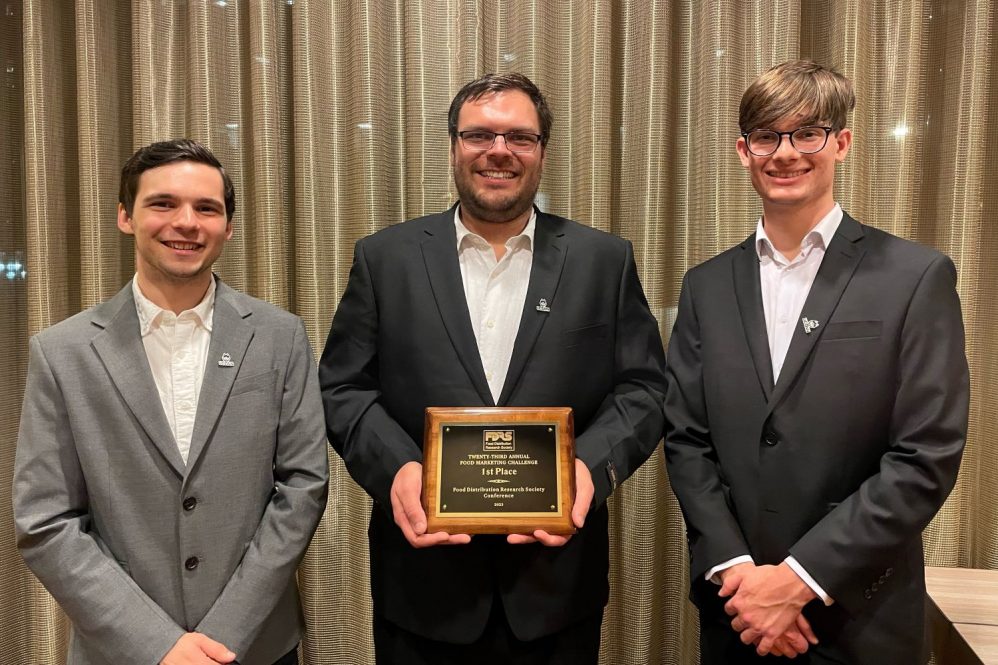A team of UConn students ended 2023 on a high note when they placed first in the national Food Distribution Research Society (FDRS) Student Food Marketing Challenge.
The team was made up of three students in the College of Agriculture, Health and Natural Resources’ Department of Agricultural and Resource Economics: John Daly ’23 ’24 (CAHNR), William Hiers ’24, and Jacob Timchak ’25. Cristina Connolly, assistant professor, organized the team.
Connolly previously worked at California Polytechnic State University which had a large agribusiness program, so she had previous experience organizing student teams for this competition. 2023 marked the second year Connolly led a team of UConn students to FDRS.
“I took it over when I was at Cal Poly and really enjoyed doing it so when I moved to Connecticut, I thought why don’t we try and build a team here,” Connolly says.
Most teams come from parts of the country with larger agricultural sectors like the Midwest, making UConn’s entry unique.
As part of the competition, all teams are given a real-world problem with the task of developing strategies to address the issue at hand. The UConn team was assigned an Uzbekistani company, Metin LLC, looking to expand into international markets beyond Russia. The team looked at various food products, namely fresh and dried fruits, and identified which foreign markets would be the best fit for those products.
This was a unique challenge as most problems come from local agricultural businesses.
“That offered a plethora of opportunities as well because the company wasn’t really that established. Essentially, they said ‘the whole world is your sandbox, what can you do to make us money?’” Hiers says. “It allowed us to get creative with it.”
The teams were given the challenge and then had one week to research and prepare. During that time, they had the opportunity to ask the competition organizer questions about the challenge. Then they had a week to craft their solution.
The team spent many late nights crafting and re-crafting solutions.
“It was a lot of trial and error, because we could go through one avenue, realize there wasn’t much for us there and then switch to a different one,” Daly says. “There must have been three or four final solution presentation drafts before we got to our last one, a really good one.”
Ultimately the team decided to recommend the company sell fresh fruit to China and dried fruit to the United Kingdom.
“Every single solution you come up with is going to have a seemingly endless list of positives and negatives,” says Timchak. “Being that we don’t have experience exporting from Uzbekistan or knowledge of the language, it was tough to try and really weigh these pros and cons and understand what was going on.”
The team had the opportunity to apply conceptual knowledge they learned in their classes about the “Four Ps” – product, placement, price, and promotion – to a real situation.
“Something I hoped to get out of this experience was working with a real-life problem, working with a real-life company,” Hiers says. “And it definitely was an eye-opening experience in terms of that.”
The UConn team had to progress through the competition before they could take home the top prize. The competition consists of a virtual and in-person component. First, a dozen teams from around the country submitted their video presentations. The top three teams were invited to present live in Washington, D.C. in November 2023.
In D.C., the team gave their 20-minute presentation followed by a Q+A session from a panel of judges. The Q+A allowed the team to demonstrate the research and thought they had put into the project and also added to the experiential learning opportunity.
The team says the judges noted how their presentation stood out thanks to the depth of their research and financial analyses, putting their work above and beyond that of the other teams.
“I think we all work really well together,” Timchak says. “We all have individual strengths that worked well, and I never felt like we were clashing.”
At the end of the competition, the company received the solutions the teams generated.
“Because these are real clients, the solutions that all three teams came up with are all getting sent to Metin,” Connolly says. “So, there could potentially be real impacts from the results of this competition, it’s not just theoretical.”
This work relates to CAHNR’s Strategic Vision area focused on Ensuring a Vibrant and Sustainable Agricultural Industry and Food Supply.
Follow UConn CAHNR on social media



